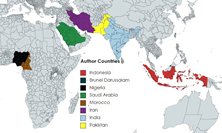Comparison of Pressure Sensor in Flow Analyzer Design for Peep Measurement on Ventilators
Abstract
The PEEP parameter is one of the parameters that need to be considered in mechanical ventilation because inappropriate parameter values can increase the risk of death for patients. Monitoring of these parameters can be done using a flow analyzer. The purpose of this study is to find out which pressure sensor is stable and has high accuracy. This study compares MPX2010DP and MPX5010DP pressure sensors where the readings of the two sensors will be compared with the pressure read by DPM (Digital Pressure Meter). The pressure read is the pressure obtained from the lung test with 11 pressure reading points and carried out as many as 5 experiments. The results of this study found that the smallest percentage of error was found in the MPX2010DP sensor at a pressure of 5 cmH2O rising pressure and 20 cmH2O rising pressure with an error percentage of 0.00%, while the largest percentage of error was found in the MPX2010DP sensor at a pressure of 5 cmH2O down pressure with an error percentage of 5.16%. The largest standard deviation value is 0.52 found on the MPX5010DP sensor at a pressure of 20 cmH2O rising pressure. The greatest uncertainty value is 0.23 found in the MPX5010DP sensor at a pressure of 20 cmH2O rising pressure. While the largest correction value is 0.54 on the MPX5010DP sensor at a pressure of 25 cmH2O rising pressure. From the data obtained, it can be said that the sensor MPX2010DP more accurate and more stable.

This work is licensed under a Creative Commons Attribution-ShareAlike 4.0 International License.
Authors who publish with this journal agree to the following terms:
- Authors retain copyright and grant the journal right of first publication with the work simultaneously licensed under a Creative Commons Attribution License that allows others to share the work with an acknowledgement of the work's authorship and initial publication in this journal.
- Authors are able to enter into separate, additional contractual arrangements for the non-exclusive distribution of the journal's published version of the work (e.g., post it to an institutional repository or publish it in a book), with an acknowledgement of its initial publication in this journal.
- Authors are permitted and encouraged to post their work online (e.g., in institutional repositories or on their website) prior to and during the submission process, as it can lead to productive exchanges, as well as earlier and greater citation of published work (See The Effect of Open Access).











